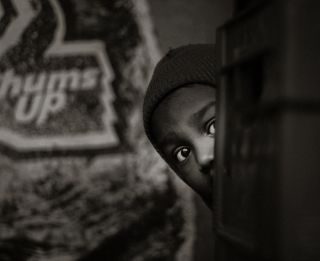Anxiety
Which Fearful Children Should We Worry About?
Three research-based insights about anxiety development.
Posted June 28, 2023 Reviewed by Abigail Fagan
Key points
- Temperament refers to the way we react to and respond to our environments; it shapes who we become.
- Fearful temperament early in childhood increases the likelihood of anxiety.
- How caregivers respond to their child’s fearful behavior can either make anxiety more or less likely.
As a psychologist, I’m interested in how children learn to control their emotions and behavior (or regulation), what individual characteristics (temperament) put children at risk for developing problematic behaviors, and what social and environmental factors (like caregiving, peers, major life transitions such as starting high school, and events such as the pandemic) contribute to either positive or negative outcomes for children. In particular, my colleagues and I are focused on the emotions of fear and anxiety. If I can summarize my 30+ year program of research in one sentence it is this: Which fearful children should we worry about? In this one sentence, there are a few things to highlight that will set the stage for understanding our approach and provide some useful information.

Fear and anxiety are normal emotional responses to novelty or scary and threatening situations. Emotions lead to behavior (they motivate and move us!) and have evolutionary roots that help us survive. In the case of fear, the goal is safety. Therefore, fearfulness alone is not problematic. In fact, some children, teens, and adults are just more fearful, shy, and cautious by nature. This is what we call fearful temperament. Temperament refers to characteristics that shape the way we react to and respond to our environments and includes other traits like anger proneness, positivity, and activity level. These traits are based on our biology, and behaviors associated with these traits begin in infancy and remain quite stable throughout life. These early-emerging temperament traits are building blocks to personality and mental health.
We know from decades of research that children who are temperamentally fearful in the extreme are more likely to develop anxiety that interferes with their daily life. Most often this extreme fear of novelty turns into problems with social anxiety and can interfere with performance in school and friendships. We are still trying to connect the dots: Why does this happen? Here’s what we know so far.
1. It is not only how much fear children show, but when they show the fear that matters. Situations that are new but are intended to be fun and inviting (for example, meeting new kids in a playroom full of toys) should be less likely to result in extremely fearful behavior compared to situations that are highly novel or convey a threat to safety (for example, a stranger approaching kids on a playground). For children who react with intense fear to the first type of situation are more likely to show anxiety later in life.
2. We see differences in physiology between extremely fearful and non-fearful children. Fearful children are more biologically sensitive to stress and recovery from stress (or regulation). What we think this means is that these children may be temperamentally fearful for two reasons. First, they are simply more reactive (more easily or quickly triggered) to novelty and have a stronger fight-flight response. Second, once they are fearful, they have difficulty controlling or reducing this response. Put simply, it’s harder for them to calm down.
3. How caregivers interact with children can make a difference as well. We have found that for extremely fearful children it is best not to let children completely avoid new situations. When fearful children are allowed to avoid or when caregivers step in too quickly to help a child regulate (or overcontrolling), it increases fear and promotes an anxious response. When this cycle happens consistently it increases anxiety symptoms as children get older. Of course, caregivers naturally want to protect their children from negative feelings, but we know that helping children learn how to approach new situations (gentle encouragement to approach) and provide them with age-appropriate support to cope with it on their own (building autonomy and self-regulation skills) works to lessen anxiety over time.
As I’m writing this last section, I’m sitting on my deck, which is basically in the woods. I hear a call, like an animal distress call. As I suspected, it was a fawn calling for its mother. As I searched, I located the mother first as she was slowly walking toward her baby. Once the baby sees her it races back toward her. It’s possible, if not likely, that the mother vocalized to help the fawn locate her, but I did not hear it. No sooner does this little one return to the mother, and then they bolt away through the woods! The mother just looks on and stops to feed, at which point I notice another fawn on her heels. (Twins are quite common in deer). This second fawn appears much more cautious than the first one, who is still bounding around in the woods and running circles around mom and sibling. I watch this occur for a few more minutes until they all disappear out of my view. It is so fitting this occurred right as I was writing about differences in fearfulness and caregivers’ varied responses. It highlights how different we can be from one another, even as twins. It highlights how caregivers provide safety and support in different ways to match these differences.
References
Kiel, E. J., & Buss, K. A. (2014). Dysregulated fear in toddlerhood predicts kindergarten social withdrawal through protective parenting. Infant and Child Development, 23, 304-313. doi: DOI: 10.1002/icd.1855
Shiner, R. L., Buss, K. A., McClowry, S., Putnam, S., Saudino, K., Zentner, M. (2012). What is Temperament Now? Assessing Progress in Temperament Research on the Twenty-Fifth Anniversary of Goldsmith et al. (1987). Child Development Perspectives, 6, 436-444.
Buss, K. A. (2011). Which fearful toddlers should we worry about? Context, fear regulation and anxiety risk. Developmental Psychology, 47(3), 804–819. DOI: 10.1037/a0023227
Buss, K. A. & Kiel, E. J. (2011). Do maternal protective behaviors alleviate toddlers’ fearful distress? International Journal of Behavioral Development, 35, 136-143. DOI: 10.1177/0165025410375922


